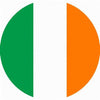How can I position the device to get a better calibration?
How does eye tracking work?
Eye tracking, or gaze interaction, is a technology used to see where a person is looking on a computer screen. To achieve this, eye tracking can be broken down into four steps: 1. The eye tracker sends out near infrared light. 2. The light is reflected on the surface of the eyes. 3. Those reflections are picked up by cameras in the eye tracker. 4. The eye tracker processes the images to know where the device user is looking on the screen. The track box, as shown in the image on the right, is the invisible 3D area where the eye tracker can capture someone's eyes. A person using an eye tracker can move around freely within this space. If the device user is having tracking issues, use these steps to help
The track box, shown in the picture above, is the invisible 3D area where the eye tracker can capture someone's eyes. A person using an eye tracker can move around freely within this space. If the device user is having tracking issues, use these steps to help.
The track box, shown in the picture above, is the invisible 3D area where the eye tracker can capture someone's eyes. A person using an eye tracker can move around freely within this space. If the device user is having tracking issues, use these steps to help.
1. Position the User
- Start by positioning the user comfortably. You want to adjust the mount to suit the user, not the other way around.
- If the user is most comfortable tilted, reclining, or laying down, those are all fine positions! We will use the mounting solution to position the device appropriately in step 3.
- Make sure the user is wearing their glasses, if they need them, and that the lenses are clean.
2. Launch Track status on the Device
- I-13 or I-16 devices: touch the button on the front of the device.
- I-12+ and I-15+ devices: press the middle button on the left side of the device (button 2).
- TD Pilot: Press the track status button on the back of the device.
- PCEye: Launch the Tobii Dynavox Eye Tracking Settings app and use the built-in Track Status window on the Calibration tab.
- Move the device closer or further away from the user until the white triangle is in the green area in the Track Status window.
3. Mount and Position the device
- Orient the device so that the user can clearly see the screen and their eyes are within the Track Status box as shown above. If the user’s head is tilted left or right, the device should also be tilted to match.
- If they are in a reclined position such as a chair that tilts or in bed, position the device higher using a mounting system such as a floor stand.
Tip: Open Track Status at the beginning of the day/session and periodically throughout to check the user’s position and adjust the device position accordingly.
4. Calibrate
- Calibrate using your preferred eye tracking software. A perfect calibration score is not required to use eye tracking effectively!
I-13, I-16, or PCEye: Use Eye Tracking Settings
I-12 or I-15: Use Gaze Interaction Settings
- Perfect calibration is not necessary to use eye tracking effectively!
- Calibrate any time you feel accuracy could be improved. Changes in lighting, positioning, medication, or mood can affect calibration.
- A calibration does not have to be green to be usable, so don't spend too long on it. Get started with your activity and revisit calibration later, after the user has gotten to practice using eye tracking
Troubleshooting
- Blinking or shifting dots in the Track Status window indicate that the eye tracker is unable to consistently identify the reflections on the eyes. This can be caused by bright overhead lights, bright sunlight, and reflective surfaces around or behind the user. Consider positioning the user so that bright light is not hitting the screen directly. Wearing a cap can also improve the eye tracker’s ability to capture reflections on the eyes.
- Most glasses and contact lenses can be used with eye tracking. Ensure that you calibrate with your glasses on, as the calibration will be different with and without. Larger lenses and frameless or partly frameless styles are best as they are less likely to block the eye. Frames that are sparkly or extremely shiny should be avoided.
- Some users naturally have droopy eyelids, which can interfere with eye tracking if the device is in a low position. Try raising the device so that the user is looking straight ahead at the screen. This lifts the upper eyelid, so that the eye tracker can see the pupil more consistently















